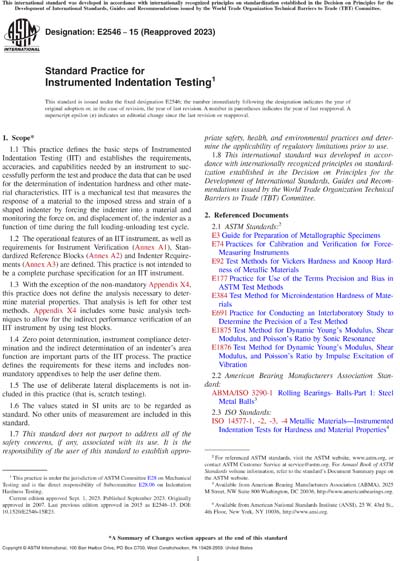Most recent
ASTM E2546-15(2023)
Standard Practice for Instrumented Indentation Testing
1.1 This practice defines the basic steps of Instrumented Indentation Testing (IIT) and establishes the requirements, accuracies, and capabilities needed by an instrument to successfully perform the test and produce the data that can be used for the determination of indentation hardness and other material characteristics. IIT is a mechanical test that measures the response of a material to the imposed stress and strain of a shaped indenter by forcing the indenter into a material and monitoring the force on, and displacement of, the indenter as a function of time during the full loading-unloading test cycle.
1.2 The operational features of an IIT instrument, as well as requirements for Instrument Verification (Annex A1), Standardized Reference Blocks (Annex A2) and Indenter Requirements (Annex A3) are defined. This practice is not intended to be a complete purchase specification for an IIT instrument.
1.3 With the exception of the non-mandatory Appendix X4, this practice does not define the analysis necessary to determine material properties. That analysis is left for other test methods. Appendix X4 includes some basic analysis techniques to allow for the indirect performance verification of an IIT instrument by using test blocks.
1.4 Zero point determination, instrument compliance determination and the indirect determination of an indenter’s area function are important parts of the IIT process. The practice defines the requirements for these items and includes non-mandatory appendixes to help the user define them.
1.5 The use of deliberate lateral displacements is not included in this practice (that is, scratch testing).
1.6 The values stated in SI units are to be regarded as standard. No other units of measurement are included in this standard.
1.7 This standard does not purport to address all of the safety concerns, if any, associated with its use. It is the responsibility of the user of this standard to establish appropriate safety, health, and environmental practices and determine the applicability of regulatory limitations prior to use.
1.8 This international standard was developed in accordance with internationally recognized principles on standardization established in the Decision on Principles for the Development of International Standards, Guides and Recommendations issued by the World Trade Organization Technical Barriers to Trade (TBT) Committee.
ASTM International [astm]

